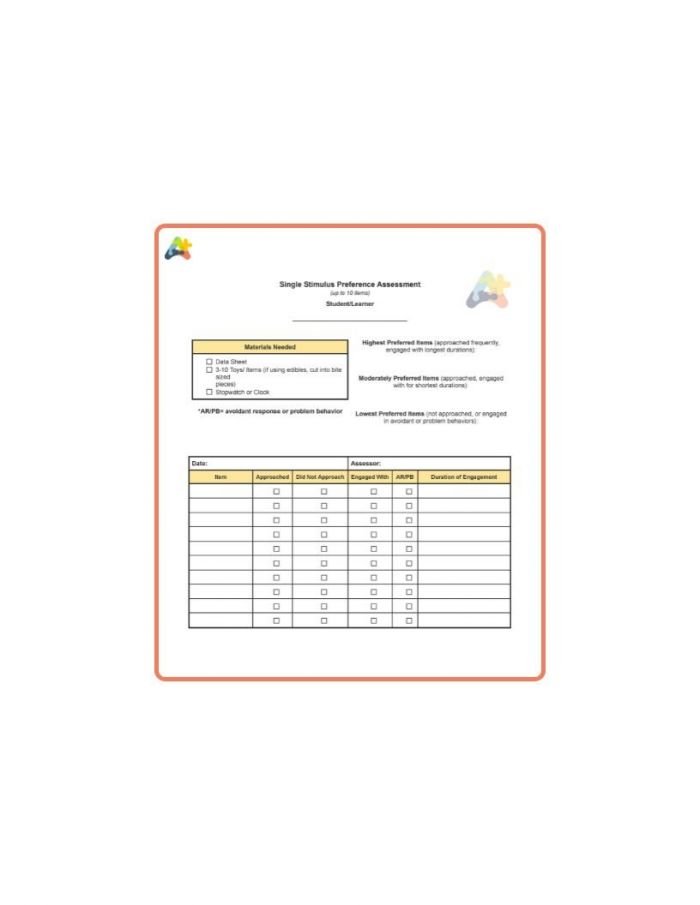
DESCRIPTION
Preference assessments are evaluations that can be done through observations or are trial-based to determine a hierarchy of items that a learner might prefer. This resource provides data tables for a Single Stimulus Preference Assessment for up to 3 separate sessions.
WHEN TO USE
Conduct a preference assessment when you want to determine a hierarchy of items your learner enjoys or prefers. A Single Stimulus Preference Assessment is appropriate for your learner if they are able to adequately select preferred items among a large variety of items and is able to tolerate when preferred items are taken away without engaging in problem behavior.
HOW TO USE
-
Gather 3-5 toys/items that your learner enjoys or might enjoy, a printed data sheet, and a stopwatch or clock to track the duration of the student’s engagement with each item.
-
Sit across from the student at a table, desk, or on the floor.
-
Place a single item from your array within reach of the child, and give the task direction, “Do you want it?” You may manipulate the toy as intended to show how it works.
-
If the student approaches the item (i.e., reaches out or takes it from you) and begins playing with it, allow the child to continue engaging with the item until they reject it (i.e., put it back the table, turn away from the item).
-
If the child engages in problem behavior, has an avoidant response (see definitions below), or does not approach the item within 10 s, remove the item.
-
Record the following on your data sheet during each trial:
-
Whether the child approaches the item (i.e., reaches out and takes it). If the child has limited motor abilities, approaching the item may mean that you place the item in front of the child, in his hands, or in his lap, and the child does not resist or reject the item. If the toy is novel, you might consider pushing buttons on the toy to showing how it works. If the child does not approach the item within 10 s, remove the item.
-
Whether the child engages with the item. For engaging with toys, this might include pushing buttons on the toy, swinging the toy around, or otherwise manipulating the toy. Engagement does not necessarily have to be manipulating the toy as it was intended, but should not include problem behavior (e.g., throwing the toy, breaking the toy). For engaging with edible items, the child engages with the item if he consumes it.
-
Whether the child has an avoidant response to the item or engages in problem behavior. This might include turning his head away from the toy, whining, screaming, aggressing, breaking the item into pieces, or throwing the items (unless throwing is an appropriate play action, e.g., with a ball). Avoidant responses and problem behavior should only be recorded during the initial presentation of items, and not after the student has engaged with the item.
-
The duration for which the child plays with the toy (i.e., the amount of time between the child’s approach and rejection of the toy). It is not necessary to record duration for consuming edible items.
-
-
Repeat steps 1-6 until you have completed your predetermined number of trials or until the child consistently rejects or does not approach any it.





